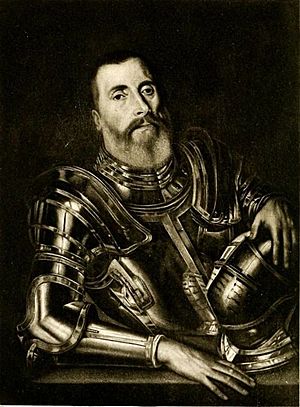Edward Osborne facts for kids
Sir Edward Osborne (born around 1530, died 1591) was a very important businessman in London during the late 1500s. He also served as the Lord Mayor of London in 1583.
Contents
Early Life and a Brave Rescue
Edward Osborne was born in Kent, England, to Richard and Jane Osborne. Around 1547, he began working as an apprentice for Sir William Hewett. Sir William was a rich cloth merchant who later became Lord Mayor of London himself. Edward joined the Clothworkers' Company, which was a powerful group for cloth merchants.
A famous story tells how Edward Osborne became well-known. Sir William Hewett's baby daughter accidentally fell into the River Thames from their home on London Bridge. Young Edward bravely jumped into the river and saved the child! This exciting event happened around 1545. Later, this same girl, Anne Hewett, became Edward Osborne's wife. Pictures showing Edward's brave rescue can still be seen today at Clothworkers' Hall and Hornby Castle, Yorkshire.
In his younger days, Edward Osborne traveled a lot, especially to places like Madrid, Spain. He became known as a smart merchant and financial agent. When his father-in-law, Sir William Hewett, passed away in 1566, Edward took over his large business and his home in Philpot Lane.
A Leading Merchant and City Leader
Edward Osborne was very active in international trade, especially with Spain and Turkey. He owned his own ship and was a key figure in the Turkey Company. This company helped English merchants trade with countries in the Middle East. Edward worked hard to get an official charter (a special permission) for the company from the Queen. He also helped the company deal with pirates and other problems that affected their ships and trade.
Edward Osborne was also involved in helping the city of London. In 1571, he joined the governors of St. Thomas's Hospital, a famous hospital in London. He later became the hospital's treasurer and then its president.
In 1573, he was chosen as an alderman for Castle Baynard Ward, which meant he was a senior member of the city council. He then became Sheriff of the City of London in 1575. This was an important role in keeping law and order.
Lord Mayor of London
In 1583, Edward Osborne was elected Lord Mayor of London. This was a very important job, making him the head of the city government. During his time as Lord Mayor, he asked officials to stop carriers from working on Sundays. He also sent Irish beggars found in London back to Ireland, asking that they not be allowed to come to the city. He also made sure the city could choose its own officials.
Because he was a respected member of the Clothworkers' Company, the Queen often asked him to help settle disagreements between merchants, especially those about the cloth trade. Like other wealthy merchants, he also handled money for important people of his time. Edward Osborne was knighted in 1584, which gave him the title "Sir." He also represented London in Parliament in 1586.
Later Life and Family
Sir Edward Osborne passed away in 1591. He was buried at St Dionis Backchurch in London, but his monument was destroyed in the Great Fire of London. He lived in his father-in-law's house in Philpot Lane, and his children were all baptized in the local church there. He also had a country home called Parsloes Manor.
Osborne's Family
Sir Edward Osborne first married Anne Hewett in 1562. She was about 18 years old and her father's only child, so she inherited a lot of land and wealth. Anne passed away young in 1585.
Edward and Anne had five children:
- Alice (born 1562 or 1563)
- Hewett (born 1566 or 1567), who later became a knight
- Anne (born 1570)
- Edward (born 1572)
- Jane (born 1578)
Sir Edward Osborne married a second time in 1588 to Margaret Chapman. They did not have any children together. Margaret died in 1602 and was buried next to Sir Edward.
Sir Edward Osborne's daughter Alice married Sir John Peyton, 1st Baronet. His grandson, also named Sir Edward Osborne, became a baronet in 1620. This grandson was the father of Sir Thomas Osborne, 1st Duke of Leeds, a very important figure in English history. A painting of Sir Edward Osborne in armor is owned by the Duke of Leeds, and a copy can be seen at Clothworkers' Hall.


